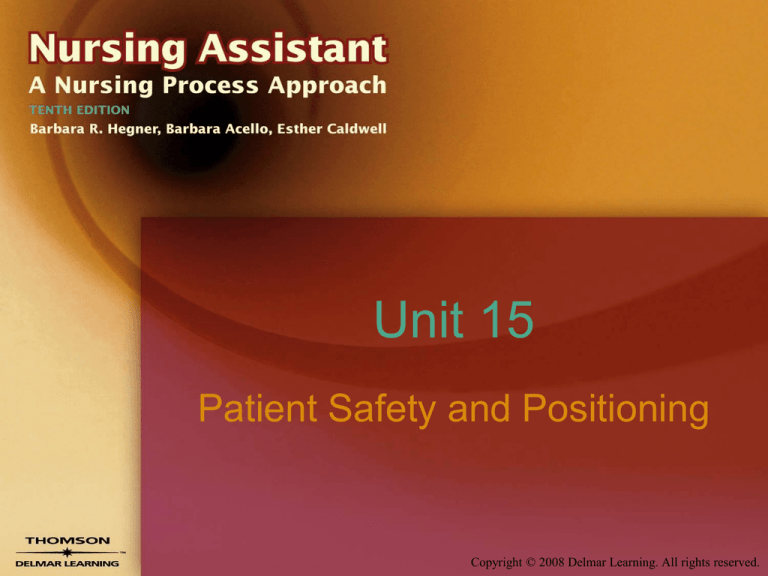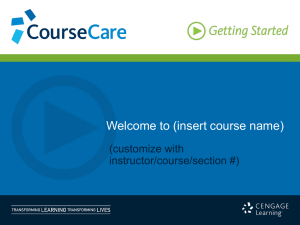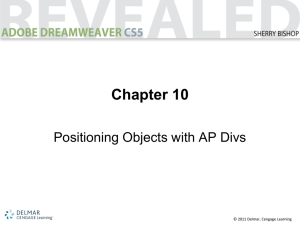
Unit 15
Patient Safety and Positioning
Copyright © 2008 Delmar Learning. All rights reserved.
Objectives
• Spell and define terms.
• Identify patients who are at risk for
having incidents.
• List alternatives to the use of physical
restraints.
Copyright © 2008 Delmar Learning. All rights reserved.
Objectives
• Describe the guidelines for the use of
restraints.
• Demonstrate the correct application of
restraints.
Copyright © 2008 Delmar Learning. All rights reserved.
Objectives
• Describe two measures for preventing
these types of incidents:
– Accidental poisoning, thermal injuries, skin
injuries, and choking
• List the elements that are common to all
procedures.
Copyright © 2008 Delmar Learning. All rights reserved.
Objectives
• Describe correct body alignment for the
patient.
• List the purposes of repositioning
patients.
Copyright © 2008 Delmar Learning. All rights reserved.
Objectives
• Demonstrate these positions using the
correct supportive devices:
– Supine, semisupine, prone, semiprone,
lateral, Fowler’s, and orthopneic
Copyright © 2008 Delmar Learning. All rights reserved.
Objectives
• Demonstrate the following procedures:
– Procedure 14 Turning the Patient Toward
You
– Procedure 15 Turning the Patient Away
from You
Copyright © 2008 Delmar Learning. All rights reserved.
Objectives
• Demonstrate the following procedures:
– Procedure 16 Moving a Patient to the Head
of the Bed
– Procedure 17 Logrolling the Patient
Copyright © 2008 Delmar Learning. All rights reserved.
Patient Safety
• In Unit 14
– You learned how to maintain a safe
environment and avoid personal injuries
– The prevention of patient injuries is another
very important part of your job as a nursing
assistant
Copyright © 2008 Delmar Learning. All rights reserved.
Use of Physical Restraints
• In the past
– Restraints were often used routinely as a
preventive measure to avoid falls
Copyright © 2008 Delmar Learning. All rights reserved.
Use of Physical Restraints
• Research has shown that side rails and
other restraints do not necessarily
accomplish this purpose
– Restraints may be used for other
preventive measures
Copyright © 2008 Delmar Learning. All rights reserved.
Copyright © 2008 Delmar Learning. All rights reserved.
Alternatives to
the Use of Restraints
• Alternatives to restraints should be tried
before restraints are applied
• Restraints are used only as a last resort
in situations in which a patient may
harm himself or herself or others
Copyright © 2008 Delmar Learning. All rights reserved.
Alternatives to
the Use of Restraints
• Nursing assistants can take a number of
actions to help reduce the need for restraints
Copyright © 2008 Delmar Learning. All rights reserved.
Potential for Side Rail Injury
• Mattresses are sometimes replaced
– Replacement may not be as large as the
original mattress
Copyright © 2008 Delmar Learning. All rights reserved.
Potential for Side Rail Injury
• Gaps between the mattress and bed
frame or rails
– Can be caused by movement or
compression of the mattress due to patient
weight, movement, or bed position
• Refer to Figures 15-10A and 15-10B
Copyright © 2008 Delmar Learning. All rights reserved.
Potential for Side Rail Injury
• If you observe a gap that is wide
enough to entrap a patient’s head or
body part
– Inform the nurse promptly
Copyright © 2008 Delmar Learning. All rights reserved.
Potential for Side Rail Injury
Copyright © 2008 Delmar Learning. All rights reserved.
Prevention of Other Incidents
• Many situations can result in an incident
that may harm a patient
• Incidents can be prevented when all
staff members are aware of appropriate
preventive measures
Copyright © 2008 Delmar Learning. All rights reserved.
Prevention of Other Incidents
• Some incidents that can be prevented
are:
– Accidental poisoning
– Thermal injuries
– Skin injuries
– Choking
Copyright © 2008 Delmar Learning. All rights reserved.
Introduction to Procedures
• Caring for patients safely means that
you must faithfully and carefully carry
out specific routines
• The normal manner of carrying out a
task is called a procedure
Copyright © 2008 Delmar Learning. All rights reserved.
Body Mechanics for the Patient
• Body mechanics for the patient
– Similar to those for the health care team
• Although the patient probably will not be
doing any lifting
– Good posture habits should not be
neglected
Copyright © 2008 Delmar Learning. All rights reserved.
Body Alignment
and Positioning
• Body alignment
– Means maintaining a person in a position
in which the body can properly function
Copyright © 2008 Delmar Learning. All rights reserved.
Complications
of Incorrect Positioning
• Complications can occur when body
alignment is not maintained
– Or when the patient’s position is not
changed often enough
Copyright © 2008 Delmar Learning. All rights reserved.
Basic Body Positions
• There are four basic positions, each
with variations:
– Prone
– Supine
– Lateral
– Fowler’s position
Copyright © 2008 Delmar Learning. All rights reserved.
Copyright © 2008 Delmar Learning. All rights reserved.
Lateral position
Copyright © 2008 Delmar Learning. All rights reserved.
Fowlers Position
HOB 90 degrees
Copyright © 2008 Delmar Learning. All rights reserved.
Semi-Fowlers Position
HOB 45 degrees
Copyright © 2008 Delmar Learning. All rights reserved.
Positioning the Patient
• After you have turned and moved the
patient into proper body alignment
– Place pillows and other supportive devices
to help the patient maintain the position
– Instructions are provided in the textbook for
the four basic positions and their variations
Copyright © 2008 Delmar Learning. All rights reserved.
Chair Positioning
• Proper chair positioning begins with the
feet
• Feet should be supported on the floor or
wheelchair footrests
• Support the patient in the 90-90-90
position while sitting in the chair
• Refer to Figure 15-40B
Copyright © 2008 Delmar Learning. All rights reserved.
Chair Positioning
• Remember that repositioning and
pressure relief are needed when the
patient is up in the chair
Copyright © 2008 Delmar Learning. All rights reserved.
Chair Positioning
Copyright © 2008 Delmar Learning. All rights reserved.
Chair Positioning
• Refer to file entitled “pre-post
procedure”
– For a review of beginning procedure
actions and procedure completion actions
Copyright © 2008 Delmar Learning. All rights reserved.







